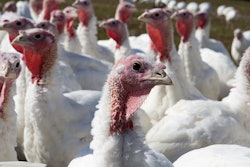
Better testing methods for Salmonella detection in poultry are needed to improve food safety, according to new research published in Applied and Environmental Microbiology.
“For the poultry industry, Salmonella is one of the leading bacterial causes of foodborne illness. And over the last few years, the poultry industry has made significant efforts to reduce Salmonella in broiler production,” explained Nikki Shariat, corresponding author of the study and an assistant professor in the University of Georgia College of Veterinary Medicine.
“Unfortunately, despite this, the number of human cases of Salmonella that are associated with poultry products hasn't really decreased as much as you would expect it to given the reduction of Salmonella in broilers.”
Salmonella infections remain constant
The research analyzed national Salmonella data compiled between 2016 and 2020 by the U.S. Department of Agriculture (USDA) Food Safety Inspection Service (FSIS).
Overall, cases of Salmonella contamination in chicken decreased from 9% in 2016 to 6.57% in 2020, however, the number of people infected with Salmonella in the U.S. remained constant over the four-year period.
“This suggests that some of the serotypes of Salmonella that are still able to make it through processing are more highly associated with human illness,” Shariat said.
“The trends that we've seen suggests that there's a need for either additional interventions in pre-harvest or interventions that are targeted towards specific serotypes of concern.”
Salmonella control with CRISPR
In partnership with the Georgia Poultry Lab Network, Shariot’s lab tested several samples using a technique called CRISPR-SeroSeq to determine which strains of Salmonella were present in breeder chickens versus chicken products.
“CRISPR-SeroSeq is an amplicon PCR-based next generation sequencing tool that allows us to identify multiple serotypes in an individual sample,” said Shariat.
The technique found several Salmonella serotypes in the live birds that were not identified by traditional approaches.
Both approaches detected abundant levels of the Kentucky serotype, which isn’t commonly associated with human illnesses. However, only CRISPR-SeroSeq identified Infantis, Enteritidis and Schwarzengrund, serotypes that cause foodborne illnesses in people.
“Controlling Salmonella in poultry production is very complex,” she added. “Being able to use high resolution approaches like this to see where Salmonella is entering my production chain is going to give processors more information to develop better controls.”

















